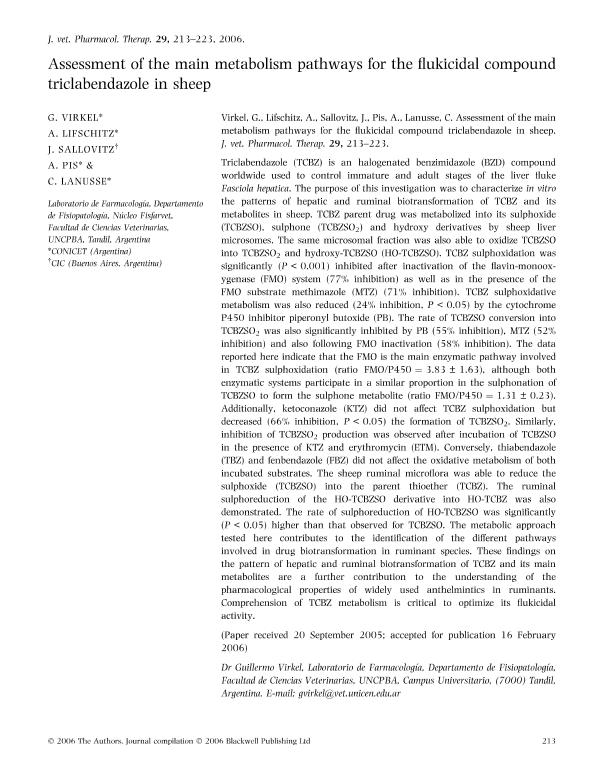Mostrar el registro sencillo del ítem
dc.contributor.author
Virkel, Guillermo Leon

dc.contributor.author
Lifschitz, Adrian Luis

dc.contributor.author
Sallovitz, Juan Manuel

dc.contributor.author
Pis, Alejandra
dc.contributor.author
Lanusse, Carlos Edmundo

dc.date.available
2020-05-19T15:03:10Z
dc.date.issued
2006-06
dc.identifier.citation
Virkel, Guillermo Leon; Lifschitz, Adrian Luis; Sallovitz, Juan Manuel; Pis, Alejandra; Lanusse, Carlos Edmundo; Assessment of the main metabolism pathways for the flukicidal compound triclabendazole in sheep; Wiley Blackwell Publishing, Inc; Journal of Veterinary Pharmacology and Therapeutics; 29; 3; 6-2006; 213-223
dc.identifier.issn
0140-7783
dc.identifier.uri
http://hdl.handle.net/11336/105461
dc.description.abstract
Triclabendazole (TCBZ) is an halogenated benzimidazole (BZD) compound worldwide used to control immature and adult stages of the liver fluke Fasciola hepatica. The purpose of this investigation was to characterize in vitro the patterns of hepatic and ruminal biotransformation of TCBZ and its metabolites in sheep. TCBZ parent drug was metabolized into its sulphoxide (TCBZSO), sulphone (TCBZSO2) and hydroxy derivatives by sheep liver microsomes. The same microsomal fraction was also able to oxidize TCBZSO into TCBZSO2 and hydroxy‐TCBZSO (HO‐TCBZSO). TCBZ sulphoxidation was significantly (P < 0.001) inhibited after inactivation of the flavin‐monooxygenase (FMO) system (77% inhibition) as well as in the presence of the FMO substrate methimazole (MTZ) (71% inhibition). TCBZ sulphoxidative metabolism was also reduced (24% inhibition, P < 0.05) by the cytochrome P450 inhibitor piperonyl butoxide (PB). The rate of TCBZSO conversion into TCBZSO2 was also significantly inhibited by PB (55% inhibition), MTZ (52% inhibition) and also following FMO inactivation (58% inhibition). The data reported here indicate that the FMO is the main enzymatic pathway involved in TCBZ sulphoxidation (ratio FMO/P450 = 3.83 ± 1.63), although both enzymatic systems participate in a similar proportion in the sulphonation of TCBZSO to form the sulphone metabolite (ratio FMO/P450 = 1.31 ± 0.23). Additionally, ketoconazole (KTZ) did not affect TCBZ sulphoxidation but decreased (66% inhibition, P < 0.05) the formation of TCBZSO2. Similarly, inhibition of TCBZSO2 production was observed after incubation of TCBZSO in the presence of KTZ and erythromycin (ETM). Conversely, thiabendazole (TBZ) and fenbendazole (FBZ) did not affect the oxidative metabolism of both incubated substrates. The sheep ruminal microflora was able to reduce the sulphoxide (TCBZSO) into the parent thioether (TCBZ). The ruminal sulphoreduction of the HO‐TCBZSO derivative into HO‐TCBZ was also demonstrated. The rate of sulphoreduction of HO‐TCBZSO was significantly (P < 0.05) higher than that observed for TCBZSO. The metabolic approach tested here contributes to the identification of the different pathways involved in drug biotransformation in ruminant species. These findings on the pattern of hepatic and ruminal biotransformation of TCBZ and its main metabolites are a further contribution to the understanding of the pharmacological properties of widely used anthelmintics in ruminants. Comprehension of TCBZ metabolism is critical to optimize its flukicidal activity.
dc.format
application/pdf
dc.language.iso
eng
dc.publisher
Wiley Blackwell Publishing, Inc

dc.rights
info:eu-repo/semantics/openAccess
dc.rights.uri
https://creativecommons.org/licenses/by-nc-sa/2.5/ar/
dc.subject.classification
Ciencias Veterinarias

dc.subject.classification
Ciencias Veterinarias

dc.subject.classification
CIENCIAS AGRÍCOLAS

dc.title
Assessment of the main metabolism pathways for the flukicidal compound triclabendazole in sheep
dc.type
info:eu-repo/semantics/article
dc.type
info:ar-repo/semantics/artículo
dc.type
info:eu-repo/semantics/publishedVersion
dc.date.updated
2020-05-05T16:08:03Z
dc.identifier.eissn
1365-2885
dc.journal.volume
29
dc.journal.number
3
dc.journal.pagination
213-223
dc.journal.pais
Reino Unido

dc.journal.ciudad
Londres
dc.description.fil
Fil: Virkel, Guillermo Leon. Universidad Nacional del Centro de la Provincia de Buenos Aires. Facultad de Ciencias Veterinarias. Departamento de Fisiopatología. Laboratorio de Farmacología; Argentina. Provincia de Buenos Aires. Gobernación. Comisión de Investigaciones Científicas; Argentina. Consejo Nacional de Investigaciones Científicas y Técnicas; Argentina
dc.description.fil
Fil: Lifschitz, Adrian Luis. Consejo Nacional de Investigaciones Científicas y Técnicas; Argentina. Universidad Nacional del Centro de la Provincia de Buenos Aires. Facultad de Ciencias Veterinarias. Departamento de Fisiopatología. Laboratorio de Farmacología; Argentina. Provincia de Buenos Aires. Gobernación. Comisión de Investigaciones Científicas; Argentina
dc.description.fil
Fil: Sallovitz, Juan Manuel. Universidad Nacional del Centro de la Provincia de Buenos Aires. Facultad de Ciencias Veterinarias. Departamento de Fisiopatología. Laboratorio de Farmacología; Argentina
dc.description.fil
Fil: Pis, Alejandra. Universidad Nacional del Centro de la Provincia de Buenos Aires. Facultad de Ciencias Veterinarias. Departamento de Fisiopatología. Laboratorio de Farmacología; Argentina
dc.description.fil
Fil: Lanusse, Carlos Edmundo. Provincia de Buenos Aires. Gobernación. Comisión de Investigaciones Científicas; Argentina. Universidad Nacional del Centro de la Provincia de Buenos Aires. Facultad de Ciencias Veterinarias. Departamento de Fisiopatología. Laboratorio de Farmacología; Argentina. Consejo Nacional de Investigaciones Científicas y Técnicas; Argentina
dc.journal.title
Journal of Veterinary Pharmacology and Therapeutics

dc.relation.alternativeid
info:eu-repo/semantics/altIdentifier/doi/http://dx.doi.org/10.1111/j.1365-2885.2006.00735.x
dc.relation.alternativeid
info:eu-repo/semantics/altIdentifier/url/https://onlinelibrary.wiley.com/doi/abs/10.1111/j.1365-2885.2006.00735.x
Archivos asociados
